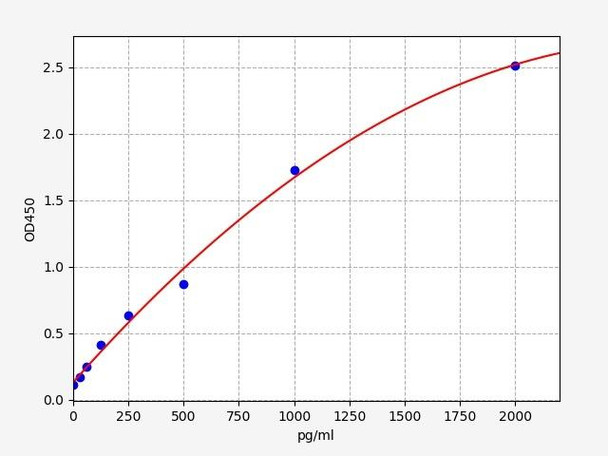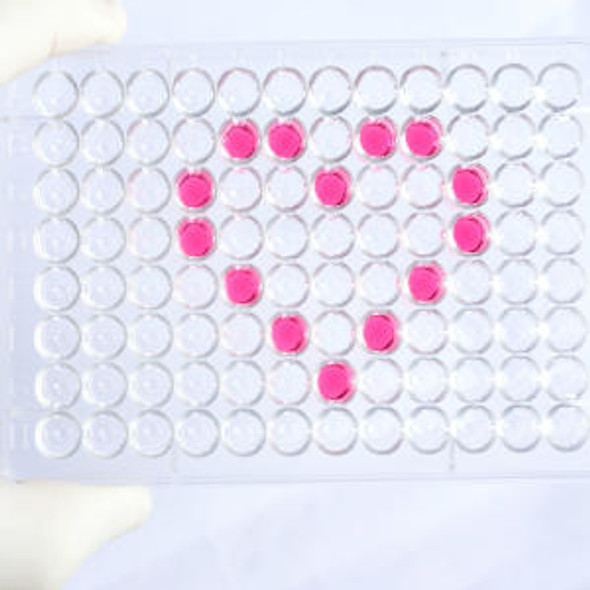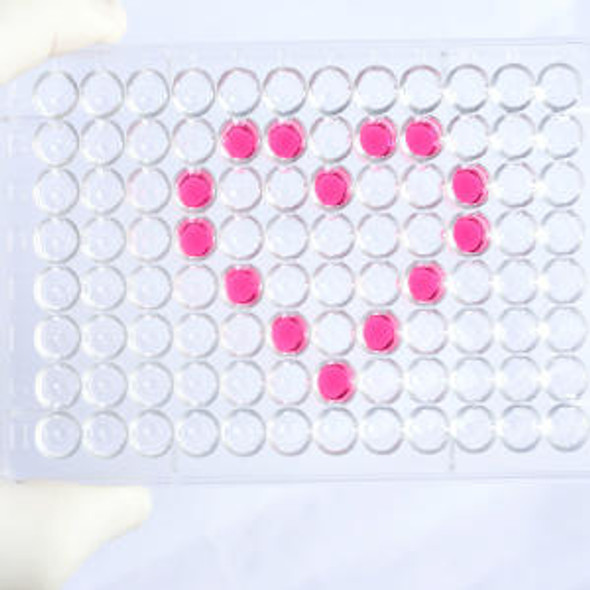Human TAF9 (Transcription initiation factor TFIID subunit 9) ELISA Kit (HUFI08393)
- SKU:
- HUFI08393
- Product Type:
- ELISA Kit
- Size:
- 96 Assays
- Uniprot:
- Q16594
- Sensitivity:
- 18.75pg/ml
- Range:
- 31.25-2000pg/ml
- ELISA Type:
- Sandwich
- Synonyms:
- AD 004, AK6, CGI 137, CINAP, CIP, STAF31/32, TAF2G, TAF9, TAFII 31, TAFII 32, TAFII31, TAFII32, TAFIID32
- Reactivity:
- Human
Description
Human TAF9 (Transcription initiation factor TFIID subunit 9) ELISA
TAF9 (TATA-Box Binding Protein Associated Factor 9) is a Protein Coding gene. Diseases associated with TAF9 include Ectodermal Dysplasia 1A and 2, and ectrodactyly-ectodermal dysplasia syndrome. An important paralog of TAF9 is TAF10. The TAF9 family consists of a pair of transcription factors: TAF9 and TAF9B. These proteins are involved in both transcriptional activation and repression of various but overlapping gene sets. It may have a role in gene regulation associated with apoptosis.
| Product Name: | Human TAF9 (Transcription initiation factor TFIID subunit 9) ELISA Kit |
| Product Code: | HUFI08393 |
| Size: | 96 Assays |
| Alias: | AD 004 ELISA Kit, AK6 ELISA Kit, CGI 137 ELISA Kit, CINAP ELISA Kit, CIP ELISA Kit, STAF31/32 ELISA Kit, TAF2G ELISA Kit, TAF9 ELISA Kit, TAFII 31 ELISA Kit, TAFII 32 ELISA Kit, TAFII31 ELISA Kit, TAFII32 ELISA Kit, TAFIID32 ELISA Kit |
| Detection method: | Sandwich ELISA, Double Antibody |
| Application: | This immunoassay kit allows for the in vitro quantitative determination of Human TAF9 (Transcription initiation factor TFIID subunit 9) concentrations in serum plasma and other biological fluids. |
| Sensitivity: | < 18.75pg/ml |
| Range: | 31.25-2000pg/ml |
| Storage: | 4°C for 6 months |
| Note: | For Research Use Only |
| Recovery: | Matrices listed below were spiked with certain level of Human TAF9 (Transcription initiation factor TFIID subunit 9) and the recovery rates were calculated by comparing the measured value to the expected amount of Human TAF9 (Transcription initiation factor TFIID subunit 9) in samples. | ||||||||||||||||
| |||||||||||||||||
| Linearity: | The linearity of the kit was assayed by testing samples spiked with appropriate concentration of Human TAF9 (Transcription initiation factor TFIID subunit 9) and their serial dilutions. The results were demonstrated by the percentage of calculated concentration to the expected. | ||||||||||||||||
| |||||||||||||||||
| CV(%): | Intra-Assay: CV<8% Inter-Assay: CV<10% |
| Component | Quantity | Storage |
| ELISA Microplate (Dismountable) | 8×12 strips | 4°C for 6 months |
| Lyophilized Standard | 2 | 4°C/-20°C |
| Sample/Standard Dilution Buffer | 20ml | 4°C |
| Biotin-labeled Antibody(Concentrated) | 120ul | 4°C (Protect from light) |
| Antibody Dilution Buffer | 10ml | 4°C |
| HRP-Streptavidin Conjugate(SABC) | 120ul | 4°C (Protect from light) |
| SABC Dilution Buffer | 10ml | 4°C |
| TMB Substrate | 10ml | 4°C (Protect from light) |
| Stop Solution | 10ml | 4°C |
| Wash Buffer(25X) | 30ml | 4°C |
| Plate Sealer | 5 | - |
Other materials and equipment required:
- Microplate reader with 450 nm wavelength filter
- Multichannel Pipette, Pipette, microcentrifuge tubes and disposable pipette tips
- Incubator
- Deionized or distilled water
- Absorbent paper
- Buffer resevoir
| UniProt Protein Function: | TAFII31: a component of the transcription factor IID (TFIID) complex, PCAF histone acetylase complex and TBP-free TAFII complex (TFTC). TIIFD is essential for mediating regulation of RNA polymerase transcription. TAFII31 binds to p53, the basal transcription factor GTF2B, and the acidic transactivator viral protein 16 (VP16). It is a coactivator for P53. |
| UniProt Protein Details: | Protein type:EC 2.7.4.3; Transcription initiation complex; DNA-binding; Acetyltransferase; Kinase, other Chromosomal Location of Human Ortholog: 5q13.2 Cellular Component: nucleoplasm; PCAF complex; transcription factor TFIID complex Molecular Function:protein binding; histone acetyltransferase activity; DNA binding; transcription activator binding; protein heterodimerization activity; p53 binding; transcription coactivator activity Biological Process: transcription from RNA polymerase II promoter; transcription initiation from RNA polymerase II promoter; establishment and/or maintenance of chromatin architecture; viral reproduction; protein stabilization; RNA elongation from RNA polymerase II promoter; gene expression; positive regulation of transcription from RNA polymerase II promoter; positive regulation of cell growth; negative regulation of proteasomal ubiquitin-dependent protein catabolic process; response to DNA damage stimulus; negative regulation of apoptosis |
| NCBI Summary: | Initiation of transcription by RNA polymerase II requires the activities of more than 70 polypeptides. The protein that coordinates these activities is transcription factor IID (TFIID), which binds to the core promoter to position the polymerase properly, serves as the scaffold for assembly of the remainder of the transcription complex, and acts as a channel for regulatory signals. TFIID is composed of the TATA-binding protein (TBP) and a group of evolutionarily conserved proteins known as TBP-associated factors or TAFs. TAFs may participate in basal transcription, serve as coactivators, function in promoter recognition or modify general transcription factors (GTFs) to facilitate complex assembly and transcription initiation. This gene encodes one of the smaller subunits of TFIID that binds to the basal transcription factor GTF2B as well as to several transcriptional activators such as p53 and VP16. In human, TAF9 and AK6 (GeneID: 102157402) are two distinct genes that share 5' exons. A similar but distinct gene (TAF9L) has been found on the X chromosome and a pseudogene has been identified on chromosome 19. Alternative splicing results in multiple transcript variants. [provided by RefSeq, Sep 2013] |
| UniProt Code: | Q16594 |
| NCBI GenInfo Identifier: | 2498981 |
| NCBI Gene ID: | 6880 |
| NCBI Accession: | Q16594.1 |
| UniProt Related Accession: | Q16594 |
| Molecular Weight: | |
| NCBI Full Name: | Transcription initiation factor TFIID subunit 9 |
| NCBI Synonym Full Names: | TATA-box binding protein associated factor 9 |
| NCBI Official Symbol: | TAF9 |
| NCBI Official Synonym Symbols: | TAF2G; TAFII31; TAFII32; MGC:5067; TAFII-31; TAFII-32; TAFIID32; STAF31/32 |
| NCBI Protein Information: | transcription initiation factor TFIID subunit 9 |
| UniProt Protein Name: | Transcription initiation factor TFIID subunit 9 |
| UniProt Synonym Protein Names: | RNA polymerase II TBP-associated factor subunit G; STAF31/32; Transcription initiation factor TFIID 31 kDa subunit; TAFII-31; TAFII31; Transcription initiation factor TFIID 32 kDa subunit; TAFII-32; TAFII32 |
| Protein Family: | Transcription initiation factor |
| UniProt Gene Name: | TAF9 |
| UniProt Entry Name: | TAF9_HUMAN |
*Note: Protocols are specific to each batch/lot. For the correct instructions please follow the protocol included in your kit.
Before adding to wells, equilibrate the SABC working solution and TMB substrate for at least 30 min at 37 °C. When diluting samples and reagents, they must be mixed completely and evenly. It is recommended to plot a standard curve for each test.
| Step | Protocol |
| 1. | Set standard, test sample and control (zero) wells on the pre-coated plate respectively, and then, record their positions. It is recommended to measure each standard and sample in duplicate. Wash plate 2 times before adding standard, sample and control (zero) wells! |
| 2. | Aliquot 0.1ml standard solutions into the standard wells. |
| 3. | Add 0.1 ml of Sample / Standard dilution buffer into the control (zero) well. |
| 4. | Add 0.1 ml of properly diluted sample ( Human serum, plasma, tissue homogenates and other biological fluids.) into test sample wells. |
| 5. | Seal the plate with a cover and incubate at 37 °C for 90 min. |
| 6. | Remove the cover and discard the plate content, clap the plate on the absorbent filter papers or other absorbent material. Do NOT let the wells completely dry at any time. Wash plate X2. |
| 7. | Add 0.1 ml of Biotin- detection antibody working solution into the above wells (standard, test sample & zero wells). Add the solution at the bottom of each well without touching the side wall. |
| 8. | Seal the plate with a cover and incubate at 37 °C for 60 min. |
| 9. | Remove the cover, and wash plate 3 times with Wash buffer. Let wash buffer rest in wells for 1 min between each wash. |
| 10. | Add 0.1 ml of SABC working solution into each well, cover the plate and incubate at 37 °C for 30 min. |
| 11. | Remove the cover and wash plate 5 times with Wash buffer, and each time let the wash buffer stay in the wells for 1-2 min. |
| 12. | Add 90 µL of TMB substrate into each well, cover the plate and incubate at 37 °C in dark within 10-20 min. (Note: This incubation time is for reference use only, the optimal time should be determined by end user.) And the shades of blue can be seen in the first 3-4 wells (with most concentrated standard solutions), the other wells show no obvious color. |
| 13. | Add 50 µL of Stop solution into each well and mix thoroughly. The color changes into yellow immediately. |
| 14. | Read the O.D. absorbance at 450 nm in a microplate reader immediately after adding the stop solution. |
When carrying out an ELISA assay it is important to prepare your samples in order to achieve the best possible results. Below we have a list of procedures for the preparation of samples for different sample types.
| Sample Type | Protocol |
| Serum | If using serum separator tubes, allow samples to clot for 30 minutes at room temperature. Centrifuge for 10 minutes at 1,000x g. Collect the serum fraction and assay promptly or aliquot and store the samples at -80°C. Avoid multiple freeze-thaw cycles. If serum separator tubes are not being used, allow samples to clot overnight at 2-8°C. Centrifuge for 10 minutes at 1,000x g. Remove serum and assay promptly or aliquot and store the samples at -80°C. Avoid multiple freeze-thaw cycles. |
| Plasma | Collect plasma using EDTA or heparin as an anticoagulant. Centrifuge samples at 4°C for 15 mins at 1000 × g within 30 mins of collection. Collect the plasma fraction and assay promptly or aliquot and store the samples at -80°C. Avoid multiple freeze-thaw cycles. Note: Over haemolysed samples are not suitable for use with this kit. |
| Urine & Cerebrospinal Fluid | Collect the urine (mid-stream) in a sterile container, centrifuge for 20 mins at 2000-3000 rpm. Remove supernatant and assay immediately. If any precipitation is detected, repeat the centrifugation step. A similar protocol can be used for cerebrospinal fluid. |
| Cell culture supernatant | Collect the cell culture media by pipette, followed by centrifugation at 4°C for 20 mins at 1500 rpm. Collect the clear supernatant and assay immediately. |
| Cell lysates | Solubilize cells in lysis buffer and allow to sit on ice for 30 minutes. Centrifuge tubes at 14,000 x g for 5 minutes to remove insoluble material. Aliquot the supernatant into a new tube and discard the remaining whole cell extract. Quantify total protein concentration using a total protein assay. Assay immediately or aliquot and store at ≤ -20 °C. |
| Tissue homogenates | The preparation of tissue homogenates will vary depending upon tissue type. Rinse tissue with 1X PBS to remove excess blood & homogenize in 20ml of 1X PBS (including protease inhibitors) and store overnight at ≤ -20°C. Two freeze-thaw cycles are required to break the cell membranes. To further disrupt the cell membranes you can sonicate the samples. Centrifuge homogenates for 5 mins at 5000xg. Remove the supernatant and assay immediately or aliquot and store at -20°C or -80°C. |
| Tissue lysates | Rinse tissue with PBS, cut into 1-2 mm pieces, and homogenize with a tissue homogenizer in PBS. Add an equal volume of RIPA buffer containing protease inhibitors and lyse tissues at room temperature for 30 minutes with gentle agitation. Centrifuge to remove debris. Quantify total protein concentration using a total protein assay. Assay immediately or aliquot and store at ≤ -20 °C. |
| Breast Milk | Collect milk samples and centrifuge at 10,000 x g for 60 min at 4°C. Aliquot the supernatant and assay. For long term use, store samples at -80°C. Minimize freeze/thaw cycles. |
Fill out our quote form below and a dedicated member of staff will get back to you within one working day!






